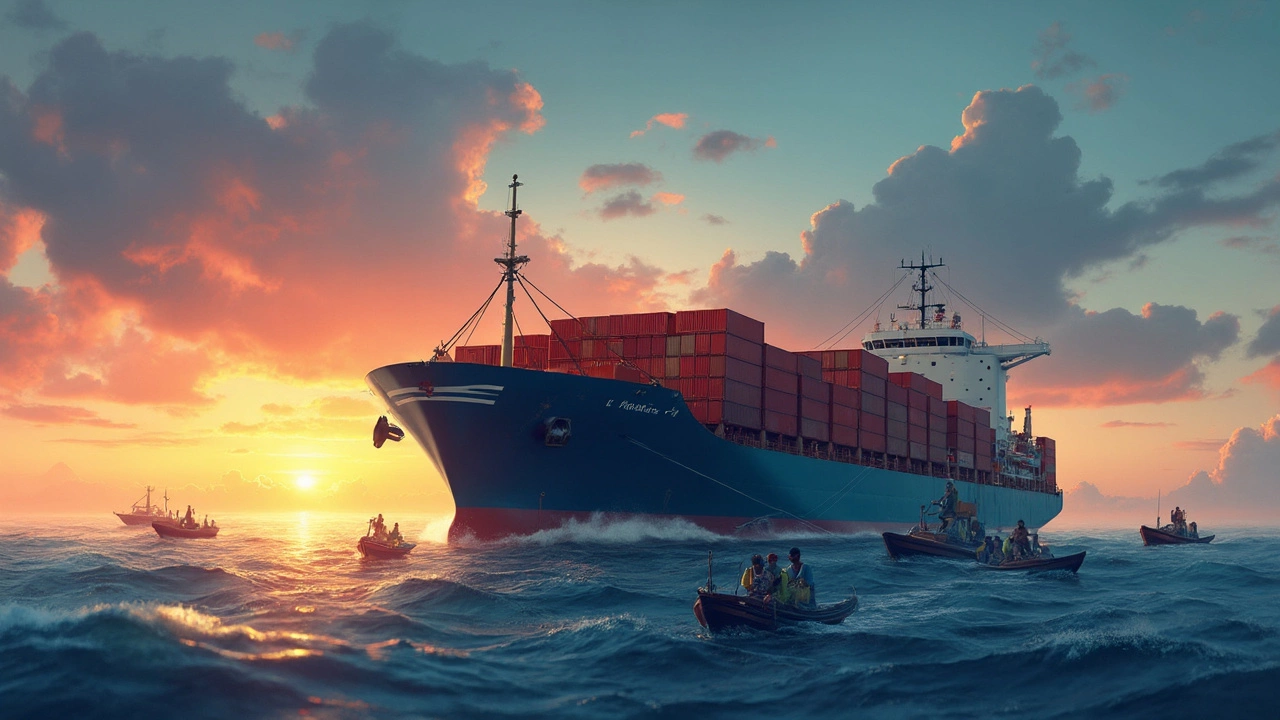Shipping internationally sounds more complicated than it really is, once you get the hang of it. Like, did you know that over 90% of the world's trade is carried by sea? That's right! So, if you're looking to ship goods, chances are you'll be dealing with either air or sea freight. Finding the right balance between cost and speed is what it's all about.
First off, figure out what works best for you. Air is quick but can be pricey, especially if you're sending large or heavy items. On the other hand, sea freight is usually cheaper but takes longer. For example, shipping a container by sea from Asia to the US can take about 15 days or more, while air would be just a matter of hours.
- Choosing the Right Shipping Method
- Navigating Customs and Regulations
- Cost-Effective Shipping Tips
- Future Trends in Shipping
Choosing the Right Shipping Method
Deciding on how to ship your goods internationally can be a bit tricky. The two heavyweights in the ring are air and sea freight. Each comes with its own set of perks and trade-offs, so picking the right one depends largely on your needs and budget.
Speed vs. Cost
If time is of the essence, you'll probably want to lean toward air freight. It's faster, but watch out for those higher costs, especially if you’re shipping something large. Imagine this: shipping a pallet from New York to London by air takes just a day or two. Meanwhile, the same goods by sea can take over a week!
Now, if your wallet is more of a concern or you’re dealing with big, bulky goods, sea freight might be more your speed. It's generally cheaper, and you'll find most businesses sending large shipments this way. Just remember, patience is key, as it can take weeks for delivery.
Choosing a Carrier
Finding a reputable carrier who knows their stuff is crucial. The big players here include FedEx, DHL, and UPS for air, while Maersk and MSC dominate the sea lanes. They offer reliable service, but it's always good to check reviews and maybe even ask around for recommendations.
Size Matters
The size and weight of your shipment can also sway your decision. Smaller packages might be better suited for air because the cost difference isn't as stark. But for larger, heavier shipments, splitting them into multiple sea containers often makes financial sense.
Additional Considerations
- Customs paperwork: No matter what method you choose, make sure your documentation is spot on to avoid delays at customs.
- Insurance: Protect your shipment with insurance, particularly if your goods are valuable or fragile.
- Tracking: Choose services with good tracking options, so you’re always in the loop.
Weigh these factors carefully, and you'll be well on your way to making the best choice for your international shipping needs.
Navigating Customs and Regulations
Dealing with customs and regulations is where many folks get tripped up when shipping internationally. There's a bit of paperwork, yeah, but once you know what you're doing, it's not too bad. Start by knowing your goods inside and out—are there import restrictions or special duties?
You'll quickly find that every country has its own rules, and they're pretty serious about them. Got a favorite snack you're sending abroad? Double-check if it's allowed. Some countries have strict regulations on food imports. Not knowing this can delay your package.
Get Ahead with Proper Documentation
Documents are your best allies here. The most important is the commercial invoice. It tells customs officials what's inside, how much it's worth, and which country it came from. Keeping this accurate is key.
- Commercial Invoice: Should include detailed descriptions and values.
- Bill of Lading: This is basically your shipment's travel ticket.
- Certificate of Origin: Sometimes needed to prove where the goods were made.
- Import License: Check if the destination country requires this.
Using a freight forwarder can save you loads of hassle. These pros handle international shipping every day and know the ins and outs of customs requirements. They'll guide you through filling out forms and can even help with shipping methods.
Monitor Tariffs and Fees
Don't forget about fees! Tariffs can add up. Every country sets tariffs, and they can change depending on current trade relations. Keeping an eye on these changes helps you plan better financially.
If you're shipping to multiple countries regularly, consider using global trade management software. These tools keep track of everything from tariffs to shipment tracking.
Staying ahead of customs and regulations is all about understanding the rules and having the right paperwork. If you get that down pat, your shipments will go a lot smoother.

Cost-Effective Shipping Tips
Saving money while shipping goods internationally isn't just a pipe dream. There are plenty of practical ways to cut costs without cutting corners. Let's dive into some smart strategies that can make international shipping more friendly on your budget.
1. Compare Different Shipping Carriers
Not all shipping carriers offer the same rates or services. It's worth checking out at least three different providers before making a decision. Some carriers might offer discounts if you're shipping in bulk or are a frequent customer, so don't shy away from asking.
2. Consolidate Shipments
If you're regularly sending smaller packages, consider grouping them together into one larger shipment. This can significantly reduce costs because carriers often give better rates for heavier shipments. It also reduces the environmental impact of sending multiple smaller ones.
3. Optimize Packaging
It might seem like a small thing, but proper packaging can save you big bucks. Use the smallest box possible that safely fits your items and helps reduce dimensional weight charges, a major factor when calculating shipping rates. Also, use lightweight materials to keep the package weight down.
4. Take Advantage of Off-Peak Seasons
Shipping during peak seasons like holidays can be costly and slow. If possible, plan your shipments during off-peak seasons to save some serious cash. Carriers often have lower rates during these slower periods due to less demand.
5. Consider Shipping Insurance Needs
While you shouldn't skimp on necessary insurance, weigh the cost of insurance against the value of the item. If you're dealing with low-value items, you might find that self-insurance (assuming the risk yourself) is more cost-effective than paying an arm and a leg for carrier insurance.
| Shipping Method | Average Cost (per kg) |
|---|---|
| Air Freight | $5 - $10 |
| Sea Freight | $1 - $4 |
Ultimately, the key to cost-effective shipping is being well-informed and flexible. With a bit of planning and some smart decisions, you can stretch your shipping budget further than you might think.
Future Trends in Shipping
It's an exciting time for international shipping. Changes are coming fast with technology and sustainability leading the way. If you're in this game, adapting to these trends can give you a real edge.
The Push for Green Shipping
Shipping's carbon footprint is under scrutiny, and greener alternatives are gaining momentum. Major companies are investing in eco-friendly fuels like biofuels and even electric ships. It's not some distant future—it's happening now. Reducing emissions and improving fuel efficiency are becoming a big focus, not just for the environment but also to cut down costs in the long run.
Automation and AI
Technology is shaking things up. From autonomous ships like the Yara Birkeland that set sail in 2022 to AI-driven logistics platforms, automation is trimming down human error and improving efficiency. The future of shipping includes drones for last-mile delivery and blockchain for better transparency in global trade. AI is already crunching data to find the best shipping routes, reducing delays and saving money.
Digital Platforms and Big Data
Using digital platforms is becoming a standard practice. These platforms help manage everything from inventory to tracking shipments. They also collect a massive amount of data, which companies use to find patterns and make decisions. Big data is like the new gold in shipping, offering insights into optimizing routes, predicting maintenance for ships, and understanding market trends.
Flexible Logistics
As consumer habits evolve, so does the need for flexible logistics solutions. People expect faster delivery times, and companies are adapting with more strategic planning. Inventory is often kept close to hotspots to speed up delivery. Collaborative shipping, where different companies share space in the same shipping container, is on the rise to keep costs low.
What's Next?
Investing in these trends isn't just about staying relevant. It's about being forward-thinking and ready to meet the demands of a changing world. Keeping an eye on these trends will help you stay on top in the shipping industry.





